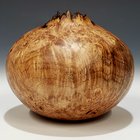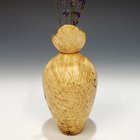I’ve been working with Tried and True varnish oil and have noticed on some woods it doesn’t seem to harden. I turn green wood usually to wall thickness of 3/8-1/4”. I let the bowls dry for a couple of weeks but don’t weight to monitor water loss. And I do follow the application instructions. Some bowls feel greasy even after drying for a week following finishing and I get a residue coming off when I rub the finish out. Anyone else notice this with TTrue on green woods?
-
December 2025 Turning Challenge: Single Tree! (click here for details) -
Congratulations to Bob Henrickson, People's Choice in the November 2025 Turning Challenge (click here for details) -
Congratulations to Steven Gordon for "Dropped Ice Cream Cone" being selected as Turning of the Week for December 8, 2025 (click here for details) -
Welcome new registering member. Your username must be your real First and Last name (for example: John Doe). "Screen names" and "handles" are not allowed and your registration will be deleted if you don't use your real name. Also, do not use all caps nor all lower case.
You are using an out of date browser. It may not display this or other websites correctly.
You should upgrade or use an alternative browser.
You should upgrade or use an alternative browser.
Tried and True varnish oil issues
- Thread starter Brian Nowak-Thompson
- Start date
Might want to try exposing the piece to sunlight or other bright light. That works for Walnut oil.
A couple of weeks is probably not enough to get the moisture content low enough. This time of year I use the trunk line away from my furnace as a drying device. It warms the wood and then it cools off with the cycling of the furnace. I start further away with a fresh bowl, and then you can put it near the furnace after a week or so. I've dried hundreds of pen blanks that way too.
very clever!A couple of weeks is probably not enough to get the moisture content low enough. This time of year I use the trunk line away from my furnace as a drying device. It warms the wood and then it cools off with the cycling of the furnace. I start further away with a fresh bowl, and then you can put it near the furnace after a week or so. I've dried hundreds of pen blanks that way too.
- Joined
- Feb 28, 2021
- Messages
- 1,770
- Likes
- 1,582
- Location
- Roulette, PA
- Website
- www.reallyruralwoodworks.com
I use T&T Varnish mostly with flatwork, which generally will be well dried wood, and have not noticed much in the way of issues, However, I did mistakenly grab that instead of Original (oil & beeswax) that I usually use with bowls and it does seem to take much longer to cure with wood that is not fully dried and stable. That bowl took several weeks (more than a month) before it stopped "weeping", Also, it can take several months for a full deep cure (some items left to sit in the sunshine can start to weep out a bit also until it is fully cured through and through)
I’ve been doing that for several years…especially to cure epoxy when tubing pen blanks. Every now & then, I find a few that I’d forgotten!!A couple of weeks is probably not enough to get the moisture content low enough. This time of year I use the trunk line away from my furnace as a drying device. It warms the wood and then it cools off with the cycling of the furnace. I start further away with a fresh bowl, and then you can put it near the furnace after a week or so. I've dried hundreds of pen blanks that way too.
Earl
I believe that tried and true has boiled linseed oil in it. That won't dry with too high of a moisture content.
I have used T&T for furniture in the past. I quickly learned that it needs a very warm environment to cure. I think I read about a flat woodworker that turns up his shop heat to the high 70s to get it to cure faster.
It has linseed oil, but NOT boiled linseed oil. Boiled linseed oil has metallic dryers added. It basically is linseed oil. It can contain up to 90% by weight of a proprietary modified linseed oil. From their SDS sheet,I believe that tried and true has boiled linseed oil in it. That won't dry with too high of a moisture content.
No heavy metal driers – metallic salts of cobalt and manganese could be a health risk to those who manufacture them. https://s3.gomedia.ws/wp-content/uploads/sites/11/2016/03/FBC-TRIED-AND-TRUE-VO_MTR_GHSF_EN.pdf
I see said the blind man
Kevin Jesequel
TOTW Team
I have been using T&T on all of my pieces for about 8 months. I mostly use their Danish oil, but have used their varnish oil on several pieces. I noticed when the weather cooled off last fall that pieces left in the shop were taking much longer to cure. I have been bringing them inside the house between coats to help with that. Even inside, the varnish oil takes a long time to fully cure. I have found that it works best if applied very, very thinly. Sanding to a high grit seems to help keep too much oil from absorbing at once. With the Danish oil, any figure looks flat after the first coat. After curing 8 or more hours inside (24 hours for varnish oil), I burnish the surface with 0000 steel wool, then apply the second coat. By the third coat, the figure will pop and thats usually where I stop. Honestly, I don't see much difference in the finished surface with Danish and the varnish oils, so I tend to just use the Danish since its quicker. If I want a shine, it buffs well.
Kevin Jesequel
TOTW Team
Kevin Jesequel
TOTW Team
I used the varnish oil blend and after three days in a warm area, and rubbing it like crazy (per the instructions), on a dry sycamore bowl; It has yet to harden and is still tacky feeling.
Thats twice I've had it remain goopy on dry wood. Not using it any more. I may try the beeswax version later. Waiting that long for something to dry is maddening!
Thats twice I've had it remain goopy on dry wood. Not using it any more. I may try the beeswax version later. Waiting that long for something to dry is maddening!
- Joined
- Feb 28, 2021
- Messages
- 1,770
- Likes
- 1,582
- Location
- Roulette, PA
- Website
- www.reallyruralwoodworks.com
Applying the varnish oil too thick to begin with (as well as the Original T&T beeswax formula) leads to poor results, I have found - You just need only enough to "dampen" the surface - a very very thin layer , then let it set for an hour before buffing it. a pint can of the varnish is about enough to finish a couple of dressers (drawers and all) - is what I mean by very thin coats. once buffed, let the first coat dry for 24 hours at least , then you can lightly sand (600 grit works nicely to polish it) and then you can apply the second coat (rub in super thin layer, set an hour, then buff, and let dry 24 hours - each time. It takes 3 or 4 coats and then plenty of buffing to get the equivalent of a semi-gloss finish. If you don't have the patience to deal with 5 to 7 days worth of finishing time, then perhaps T&T (and other pure natural oils that have only been polymerized (heated and cooled to shorten cure time) ) is not the product for you...
I get better results with walnut oil/wax. Especially on sycamore bowls. T&T did work well on walnut; but it is not going to be my go to finish that’s for sure.
We know that water and oil do not mix...Some timbers retain cellular moisture longer than others. When I've tried this, I had to get the timber drier;
period, before applying the finish.
period, before applying the finish.
I recommend setting up a “drying box” - simple as a cardboard box with a light bulb. Getting these oils up to 90-100F really helps them cure throughout thhe wood.
On mine I taped the bottom flaps at the edge so the box would stand on them, but the seams leak air. Then I just played around with the top flaps to find a configuration the kept the temp where I wanted it by allowing some air flow through the the box from thhe bottom and the flap seams.
On mine I taped the bottom flaps at the edge so the box would stand on them, but the seams leak air. Then I just played around with the top flaps to find a configuration the kept the temp where I wanted it by allowing some air flow through the the box from thhe bottom and the flap seams.
I'll stick with shellac as my main finish. Resithane for a built up finish.
I have been experimenting with buffing in a few light, thinned coats of T&T Danish Oil on dark woods like a large walnut platter I recently finished. Thin with either mineral spirits or citrus oil by dampening a rag with it, then a small dab of the oil. This allows it to be leveled super-thin if you're willing to do some sustained rubbing, wipe off vigorously several times within an hour, and then light burnishing the next day. I am getting a lot of this done on the stretch of sunny and warm/dry and breezy days we are having here in SC; my sunny back deck becomes an oil-curing station in weather like this, which helps tremendously along with light coats in getting those coats cured. If I want a little extra sheen, I'll do the same with a couple coats of their T&T Varnish Oil on top, then more buffing and burnishing. I'm liking the results with this combo so far.
Atmospheric conditions can play a huge role in reducing cure times and having success with these finishes. I can't speak to their Original, as I haven't tried it, but it seems a bit less versatile in its layering compatibility with other finishes. Like many here, I am always experimenting trying to get "the perfect finish." I figure the moment that happens, lightning will strike me and I will be transported to a heavenly meadow with the real finishing experts lol. I really need to get that famous book about wood finishes. Pretty sure I walked by it on my last trip to Woodcraft.
Atmospheric conditions can play a huge role in reducing cure times and having success with these finishes. I can't speak to their Original, as I haven't tried it, but it seems a bit less versatile in its layering compatibility with other finishes. Like many here, I am always experimenting trying to get "the perfect finish." I figure the moment that happens, lightning will strike me and I will be transported to a heavenly meadow with the real finishing experts lol. I really need to get that famous book about wood finishes. Pretty sure I walked by it on my last trip to Woodcraft.
I wrote about an oil finish curing kiln last summer, look at this thread for ideas.
Thread 'oil finish curing kiln' https://www.aawforum.org/community/threads/oil-finish-curing-kiln.22748/
And I use all three versions of T&T pretty much exclusively now.
Thread 'oil finish curing kiln' https://www.aawforum.org/community/threads/oil-finish-curing-kiln.22748/
And I use all three versions of T&T pretty much exclusively now.


